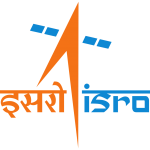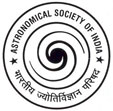February 2019:
The AstroSat Picture of the Month for February 2019 is an Ultraviolet image of the globular cluster NGC 2808, with far-ultraviolet shown in blue and near-ultraviolet in yellow. Stars emitting in both are seen in white. The red and light-blue circles show the locations of two populations of faint red-horizontal branch stars identified using UVIT-AstroSat.
Picture credit: Sarita Vig and collaborators


“AstroSat Picture of the Month” is an initiative of the Public Outreach and Education Committee of the Astronomical Society of India and the AstroSat Training and Outreach Team.
New population of Ultraviolet stars in the Globular Cluster NGC 2808
The Sun is a constant presence in our lives and is about 5 billion years old. But will the Sun itself change in the millions of years to come? Any such change will occur so far into the future, that astronomers need to look to alternate places in the sky to understand this. Globular clusters are the best laboratories to study the fate of stars. This month, APOM brings forth a globular cluster called NGC 2808 located at a distance of about 47,000 light years in the constellation Carina. This is the third globular cluster in APOM, after NGC 1851 and NGC 288.
NGC 2808 is one of the most massive globular clusters that we know, with a stellar membership of more than a million stars. Being nearly 11 billion years old, stars like the Sun and heavier stars have evolved to later stages of evolution. Due to the large number of stars present in globular clusters, stars with different masses, and in different evolutionary stages can be studied together. This is because it is believed that all stars in the cluster formed from the same material at approximately the same time. NGC 2808 is unique because very recent optical studies have shown that it houses many distinct populations of stars (five in this case) within it, the maximum found in any globular cluster till date. Stars at the same evolutionary stage but having similar masses in this cluster seem to have other properties (eg. brightness, material from which it is made) that are slightly different. These are then said to belong to different populations.
The stars that are bright in ultraviolet in this globular cluster have been studied using UVIT on-board AstroSat by a group of researchers from the Indian Institute of Space science and Technology (IIST), Trivandrum and Tata Institute of Fundamental Research, Mumbai. Using ultraviolet light from different wavebands (filters), these authors have identified stars belonging to later stages of stellar evolution, eg. Horizontal Branch stars, hot stars that have passed through the Asymptotic Giant Branch phase. They have also established the presence of four different populations of stars that are seen in the UV, including a new population for the first time. These UV populations of stars are related to the five groups of optical stars mentioned above. Earlier studies had shown the presence of a certain group of UV stars called the Red Horizontal Branch stars in the cluster. The current study has utilized the capabilities of UVIT to report that it is not one group, but rather a mixture of two different populations. This study of the UV populations in the cluster would help in refining our understanding of the formation of multiple populations in globular clusters.
The paper describing the results is accepted for publication by the Monthly Notices of Royal Astronomical Society and can be found here.
Click here for the entire APOM archive
More about ASTROSAT
AstroSat, India's first dedicated multi-wavelength space observatory, was launched by ISRO on 28 September, 2015. It has five instruments on board – the Ultra Violet Imaging Telescope, the Soft X-ray Telescope, the Large Area X-ray Proportional Counter, the Cadmium-Zinc-Telluride Imager and the Scanning Sky Monitor.
Get answers to your common queries about ASTROSAT in English, in हिंदी, and in मराठी.

